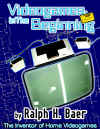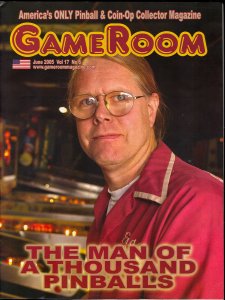

|
|
 |
GAMEROOM
June 2005
Recognize the name Antonio Meucci? No, I didn't think so. How about Alexander Graham Bell? That's an easy one, he invented the telephone. Well, as it turns out, he wasn't the first to invent a unique system that could transmit sounds and voices. Antonio Meucci had done it over 20 years before Bell and remarkably, in September 2001, the US Congress officially credited him as the real inventor of the telephone! Still, it was Bell who perfected and patented his own invention. Meucci, though, produced a wealth of evidence that proved he had created such an invention years before, but due to ill health and other circumstances, he was unable to patent it. So, what has all this got to do with the inventor of video games? It seems that in some misinformed circles there are folks who point to Atari founder Nolan Bushnell as that person. Some reach back to MIT student Steve Russell while others would argue Willy Higginbotham blipped everyone to the post. All of which would cost you your wager in a Final Jeopardy! round. Ralph Baer's book, Videogames: In The Beginning, sets the record so straight that all other video game inventor claims sound like Al Gore's suggestion he helped invent the Internet. For it is Ralph Baer, the meticulous note and record keeper, who brings forth the tonnage of evidence which crowns him as the "Father of Video Games." In fact, he knows the precise day video games were born - September 1, 1966. Trust me, the guy can prove it and does so in the pages of this absolutely fascinating book. Baer is an electronics design engineer and inventor and it was during his days at Sanders Associates in Nashua, New Hampshire when he put pencil to paper. How his "eureka moment", as he describes it, got from a yellow pad into the homes of America is something even a Hollywood screen scribe couldn't predict. It would take 6 years before his idea to play games on a TV screen would morph from pad to prototype to viable product that was licensed by Magnavox. They would refine it further (with Baer watching over their shoulders) and dub it "Skill-O-Vision", and finally bringing to market as Odyssey (featuring a very familiar game called "Ping-Pong"). The book is about as historically significant as one can get. It's packed with photos, illustrations and well-structured text that irrefutably chronicle the gestation and completion of one man's idea. You'll see interoffice memo's, hand drawn schematics, products, prototypes, clippings . it really is an amazing display of material. Baer even recounts how Sanders nearly entered the coin-op industry with a well-received video game called Hit-N-Run (it never got past a sample production run). Now, while we've established Ralph Baer as the "Father of Video Games", what about Nolan Bushnell? He's often referred to in the same way. Actually, he did play a very important part in all this, but not in the way some believe. Inspired by a Magnavox open house visit in May 1972 where they exhibited Odyssey prior to its release later that year (there's a photograph of the actual guest book page Bushnell signed!), Bushnell and Al Alcorn adapted the game's "Ping-Pong" into a coin-operated version known simply as Pong. We all know the outcome of that brilliant move so in a way, Bushnell was the "Father of Successfully Adapting Another Person's Idea For Coin-Operated Application." It was a bit like Ray Kroc when he franchised the McDonald brothers' formula for making hamburgers and fries. The McDonald brothers created it and were successful with it, but it was Ray Kroc who took that formula to a higher level. However, Bushnell "borrowed" more than just the idea and a piece of the name and by 1976 he would admit to Pong's intrinsic similarities to Odyssey's "Ping-Pong" and become the very first among many who licensed Sanders' video game patents. Baer was justifiably annoyed by Bushnell's failure to loudly admit he owed Atari's early success to a game designed at Sanders Associates in October 1967! Again, Baer delivers the substantiation and on page 46 is a full page illustration of designer Bill Rusch's early hand-drawn circuitry for "Ping-Pong." Conversely, he applauds Al Alcorn's expensive IC chip redux of "Ping-Pong." Baer eventually got the last laugh when an Atari coin-op game called Touch-Me appeared at the MOA show in 1976. Baer was inspired and he and Howard Morrison (of famed toy design company, Marvin Glass & Associates) both liked the gameplay of Touch-Me, but hated the way it was handled. Baer enlisted his friend Lenny Cope and the duo designed what would eventually become Milton Bradley's Simon (which is still in production today). Even if you're down to your last nickel and your credit card debt is tickling five figures, shun Suze Orman's advice and buy this outstanding book. It is a keepsake for those who grew up during the formative days of video games. Ralph Baer has given us a definitive accounting of who did what and backs it all up with photographic proof. We also owe an appreciative nod to Baer's publisher, Leonard Herman's Rolenta Press. Len is a superb historian and authored the book, Phoenix-The Fall And Rise Of Videogames which has seen multiple printings, all of which sell out! Videogames: In The Beginning has a 3000 copy press run so order yours today before the shelves go Baer. -Tim Ferrante